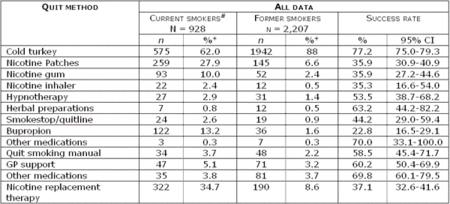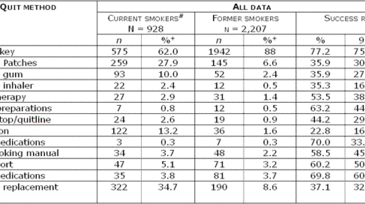Cigarette smoking continues to be a major health problem in Australia. Approximately one fifth of Australians over the age of 14 smoke daily (Australian Institute of Health and Welfare, 2002). Further, smoking related health problems contribute to about one tenth of all illness in Australia (Mathers, Vos, Stevenson, & Begg, 2001), and thus creates a large financial burden. To reduce smoking rates, and the related health problems and associated expenses that emerge as a consequence (i.e. health care costs), it is necessary to determine which smoking cessation methods are most effective. A recent study by Doran, Valenti, Robinson, Britt, and Mattick (2006) examined the success rates of various smoking cessation methods in Australia.
Researchers used data from SAND (Supplementary Analysis of Nominated Data), a subset of the ongoing annual Australian national study “Bettering the Evaluation and Care of Health” (BEACH). Between February and March 2002, and March 2003, adult patients of randomly selected participating general practitioners (GPs) completed the SAND questionnaire. As part of the SAND study, these adult patients described their smoking habits, quit attempts, and smoking status (1). All smokers were asked which method they used for their last quit attempt. Those who admitted to being ‘Former Smokers,’ either daily or occasional, were asked to indicate which methods they had used to successfully quit smoking and the length of time since their last smoke. ‘Current Smokers’ were asked whether they had tried to quit smoking during the past five years and, if so, which methods they had used to try to quit, (2) and the date of their last quit attempt.
GPs (328) collected smoking status data for 8,333 of 8,435 (98.8%) patient encounters. Of those 8,333 people surveyed, approximately 21.5% were current smokers and 27.3% were former smokers. Of the former smokers who listed a quit method (2,207), 92% used one method and 6% used two methods. Of current smokers who listed a quit method (928), 80% tried one quit method and 11% tried two quit methods. The most common method used was ‘Cold turkey’ (88% of former smokers; 62% of current smokers). ‘Cold turkey’ was the most successful method, with a success rate of 77%. The Figure summarizes the prevalence of the quit methods and their overall success rates across current and former smokers.

Figure. Method of smoking cessation at last attempt and success rate (adapted from Doran et al., 2006). Click image to enlarge
# Current smokers who have attempted to quit during past 5 years only.
+ Multiple responses were allowed, thus percentages do not add up to 100.
The initial smoking rates collected by the SAND section of the BEACH study are similar to results generated by the 2001 Australian National Drug Strategy Household survey (ANDSH; Australian Institute of Health and Welfare, 2002) and total BEACH sample, though the success rates of the SAND sample are much higher than the ANDSH rates (from February 2001). However, it is unclear how meaningful these differences are as the surveys were completed, and data was collected, at different times and possibly under different conditions. Though the success rate of ‘Cold turkey’ in the ANDSH study was 40%, it was one of the most effective methods, second only to the category ‘Other methods’ (41%).
There are several limitations to the study. The participants in the SAND study might not be representative of smokers, though the umbrella BEACH sample is representative of patients going to GPs. Further, the SAND questionnaire did not ask any questions about the process smokers go through when trying to quit smoking. The types of quit methods listed for respondents to select also limited the SAND questionnaire. Nonetheless, the SAND data, and to a lesser degree, the ANDSH data, reveal that ‘Cold turkey’ is the most, or one of the most effective ways to quit smoking. Given that this method relies solely on smokers’ motivation to quit smoking, the results of these studies imply that a person’s ‘readiness to change’ (Prochaska & DiClemente, 1983), is a key component to smoking cessation.
It is interesting that the most successful quitting method is the one that, at first impression, seems most unpleasant and the least likely to yield success. This suggests that there are significant differences between self-directed quitters and those who seek treatment to help quit smoking. Further research might examine the processes people go through when deciding to, or trying to, quit smoking, and specifically the differences among smokers from these two groups. A better understanding of the issues facing these two groups of smokers as they try to quit smoking could have important implications for the creation of smoking cessation programs and how these programs can tailor protocols to better meet the needs of smokers.
–Siri Odegaard.
Notes
1. “Current Smoking Status” (Doran et al., 2006)
1. Current smoker—daily
2.Current smoker—occasional
3.Former smoker—daily
4.Former smoker—occasional
5.Never smoked.
2. “Quit Smoking Key List” (Doran et al., 2006)
1.‘Cold turkey’ (i.e. immediate cessation with no method of assistance)
2. Nicotine patches
3. Nicotine gum
4. Nicotine inhaler
5. Hypnotherapy
6. Herbal preparations
7. Support/counseling (e.g. ‘SmokeStop’, ‘Quitline’)
8. Zyban (Bupropion)
9. Other medication
10. Self-help material (e.g. quit smoking manual)
11. GP assistance other than above (e.g. counseling)
12. Other methods not listed elsewhere
References
Australian Institute of Health and Welfare. (2002). National Drug Strategy Household Survey 2001: First results (No. AIHW Cat. No. PHE 35). Canberra: Australian Institute of Health and Welfare (AIHW).
Doran, C. M., Valenti, L., Robinson, M., Britt, H., & Mattick, R. P. (2006). Smoking status of Australian general practice patients and their attempts to quit. Addictive Behaviors, 31(5), 758-766.
Mathers, C., Vos, E., Stevenson, C., & Begg, S. (2001). The burden of disease and injury in Australia. Bulleting of the World Health Organization, 79(11), 1076-1084.
Prochaska, J. O., & DiClemente, C. C. (1983). Stages and processes of self-change of smoking: Toward an integrative model of change. Journal of Consulting and Clinical Psychology, 51(3), 390-395.
What do you think? Please use the comment link below to provide feedback on this article.




